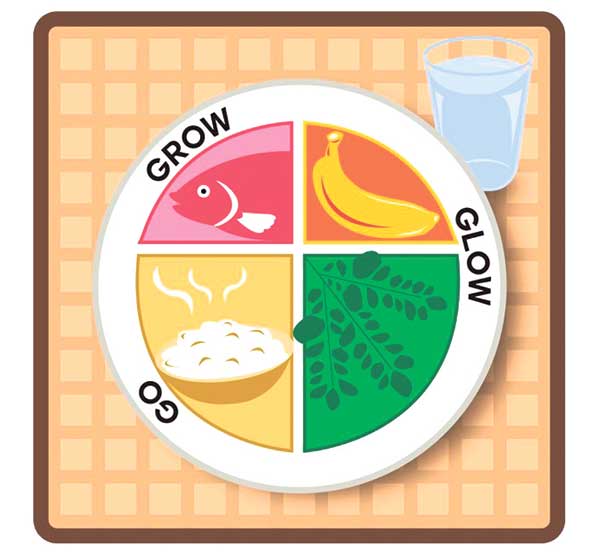The Most Important Carbs
By Justinne Lou Go, RND
“CARBS” (short term for carbohydrates) have gotten the bad rap over the years ever since sugar has been cited as an enemy. Are carbs really the enemy? Carbs are needed in the diet for the main fact that these are meant to be our main source of energy, thus the high caloric content. We do have to remember though that not all carbs were created equal. There are several classifications for carbs—simple, complex, sugars, starches, fibers, etc.—but, let’s just keep things simple; let’s look at carbs as starchy and non-starchy.

Starchy carbs are the grains and root vegetables such as rice, camote (sweet potato), corn, wheat flour, etc., which are considered energy sources because these are calorie-dense.
Non-starchy carbs are your fruits and leafy vegetables. Yes, fruits and vegetables are carbs! In fact, they’re the most important carbs for the reasons I will be enumerating further along this article.
If you have heard of the “Pinggang Pinoy” or Healthy Food Plate for Filipinos, you will find that the plate is composed of the Go, Grow and Glow foods apportioned into sections on the plate.
For a standard diet, carbohydrates are recommended to be between 45-60% of the diet for its energy-giving and bodily process-supporting properties. However, the carbohydrates with greater emphasis are the body process-regulating type—your fruits and vegetables—which should compose at least 50% of your diet; hence, the Glow foods (fruits and vegetables) occupy half of the plate.
Filling Fiber. One of the valued features of fruits and vegetables which we cannot get from other food groups (meat or fat) is fiber. This is obtained from the skins of fruits and vegetables. Fiber is often ignored, forgotten or neglected, but this unassuming super component of fruits and vegetables actually gives a wide range of benefits.
Satiety. Most people have a notion that leafy greens and vegetables are “light” food and cannot satisfy as much as meat. That is one of the most common, unfortunate misconceptions about the friendly greens as these actually pack a punch more than we think. I have heard of people who complain of getting hungry shortly after having a salad for a meal. But, if you actually check what was in their salad, it was all just leafy greens, which of course do not provide complete satiety because each meal we have should ideally contain three food groups—carbs, protein and good fat.
Although protein and fat are indeed known for their satiety factor, the fiber you get from the skins of fruits and vegetables together with the water content of these food items are the team tandem for a fully satiating meal. This is because fiber absorbs water and expands in your stomach, filling up space which then prompts signals to your brain that you’ve had your fill.
Weight management. Directly related to the abovementioned benefit of fiber, satiety kicks in sooner than when one is consuming low-fiber food, which then keeps you from eating too much. This is how fiber helps with weight loss or weight management. Of course, when one is eating a high-fiber diet, water intake should also be adequate otherwise constipation and bloating may happen.
Cholesterol-lowering. Fiber may also be your heart’s best friend as it helps lower cholesterol in the blood by removing this from your system. Cholesterol attaches to fiber in the gut, which then exits the body when you do your morninwg duty.
Healthy tummy. As if all the enumerated benefits of fiber weren’t enough, another powerful benefit worth mentioning is fiber’s role as the food of the good bacteria (probiotics) in our gut, also known as prebiotic. Prebiotics (fiber-rich food) are needed to nourish and fuel the probiotics in our gut to support our immune system.
The Original Multivitamins
The main reason why fruits and vegetables are the important carbs is because these are our only source of a wide variety of vitamins and minerals. The recommended daily intake is a minimum of five servings daily. It has been studied that consuming an average minimum of five servings of fruits and vegetables daily can provide you with enough vitamins and minerals needed for the day. Although bioavailability is now an issue with the kind of soil, farming methods and processing our fruits and vegetables go through, aiming for at least five servings a day is still better than anything less than that. I suggest having at least three servings of vegetables and two servings of fruits daily; that’s at least one serving of vegetables per meal. And remember, variety is also key to obtaining a variety of nutrients. That is why we must eat the rainbow!
Although the macros we eat generally turn into sugar either partly or completely, now you see not all carbs is the enemy and not all carbs are meant to provide energy. It’s a matter of choosing your carbs wisely. So, I hope you will now try to have at least a serving of vegetables every meal to. The benefits are there and they’re yours for the taking. Of course, if you need further guidance on this, the best person to talk to would be a Registered Nutritionist-Dietitian.




